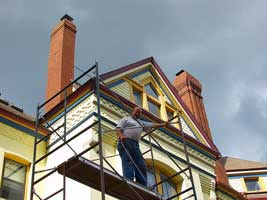The Midwest Chimney Safety Council warns homeowners to safely operate wood and gas heating appliances during periods
of bitter cold in order to avoid fire or carbon monoxide poisoning.
December 29, 2017
Kansas City, Missouri
Kansas City, Missouri
The National Fire Protection Association statistics
indicate that there are 245,000 house fires annually caused by heating equipment
such as wood-burning stoves and fireplaces. The Midwest Chimney Safety Council
believes that this number is only a fraction of the actual statistics based on
findings by chimney sweeps who service chimneys.
The NFPA states that there are 72,000 deaths caused by
Carbon Monoxide exposure annually.
During periods of very cold weather more accidental
fires and CO poisoning occur. The Midwest Chimney Safety Council recommends
that homeowners take measures to assure the safety of their family by following
these recommended guidelines:
·
Do
not use an open fireplace for heating purposes. Fireplaces are decorative
appliances to be used for ambience only. Over use of an open fireplace can
cause hidden combustibles in the walls or framing around the fireplace to ignite
and cause a house fire. This applies to manufactured fireplaces and masonry
fireplaces.
 |
C.Scott Dorret - Fotolia.com |
- Do not leave a wood-burning stove or fireplace unattended.
- Do not burn hedge, dry pine, or a Christmas tree in a fireplace or stove. These woods burn very hot and fast, and can cause a chimney fire.
- Do not burn treated wood or colored paper in a fireplace or stove. These items create toxic fumes which can cause illness or death.
- Don’t burn anything other than dry cordwood or pallet wood in a fireplace or stove.
- Have a fireplace inspected and swept annually by a professional CSIA Certified Chimney Sweep. Sweeping removes flammable creosote from the smoke chamber and flue liner. Have a wood-burning stove or insert swept twice per year.
- Keep the accumulation of flammable creosote down by using a product like Anti-Creosote Spray each time a fire is burned.
- Place ashes in an ash bucket and take outside to cool off with the lid on the bucket on a non-combustible surface before disposing of them or putting them in the garden. Ashes and embers can smolder for up to two weeks.
- Have furnace, boiler, or water heater flues inspected annually by a professional chimney sweep to assure that the flue is not clogged by nests or debris, is sized correctly, and does not have cracks or voids which can cause Carbon Monoxide backup into the home. Even low levels of CO not detectable by a CO detector can cause illness and permanent brain damage.
- Do not ignore a CO detector alarm- CO is colorless, odorless, and tasteless so there is no way a human can detect CO.
- Be sure to install new batteries and assure proper operation of smoke detectors. Install at least one smoke detector on each level of the house, including in the attic near the chimney.
- In case of a chimney fire or CO alarm, get out of the house and call the fire department immediately.
The Midwest Chimney Safety Council is a 13-state
regional association which provides educational classes and workshops to
chimney and hearth industry professionals and the public.
Contact Marge Padgitt at mcsc@mcsc-net.org or 816-461-3665 or
contact one of our members listed on the website for more information.




















